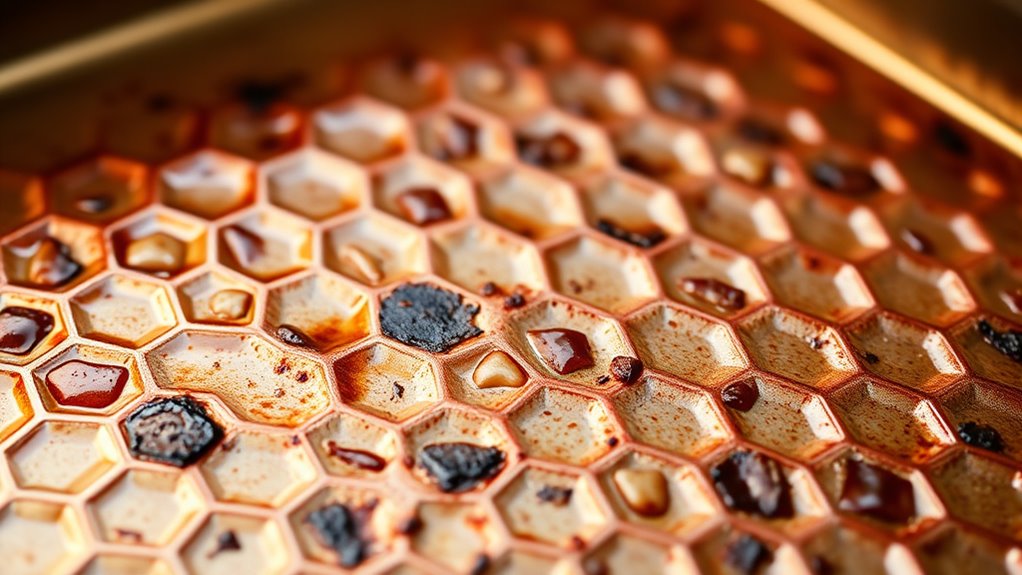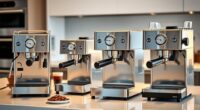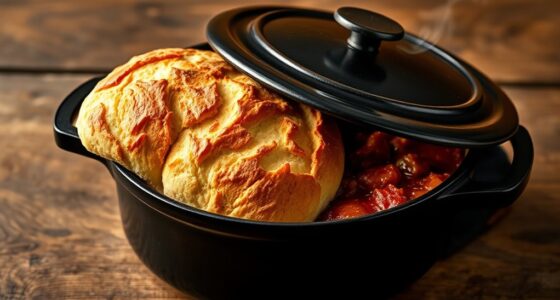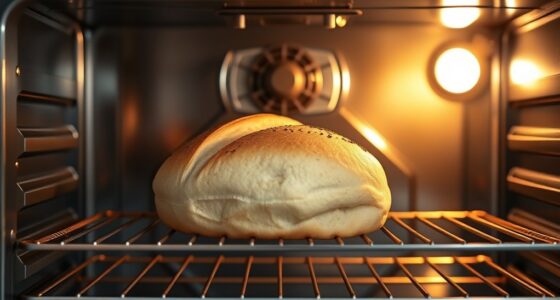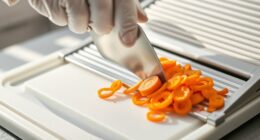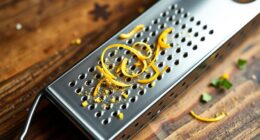To get even, golden browning, your best bet is an aluminum baking pan with a non stick coating. Aluminum heats quickly and distributes heat evenly, helping baked goods develop a nice crust without burning spots. The non stick surface makes removal easy and prevents tearing or sticking, ensuring a clean finish. When combined, these features give you predictable, professional-looking results every time. Keep exploring to discover more tips for perfect baking outcomes.
Key Takeaways
- Aluminum baking pans promote even heat distribution, ensuring consistent browning across baked goods.
- Non stick coatings help achieve a crisp exterior while preventing sticking and tearing.
- The combination of aluminum and high-quality coatings enhances control over the browning process.
- Properly designed pans prevent hot spots, reducing uneven coloring or burning.
- Durable coatings maintain their non stick and browning capabilities over repeated use.

Ever wonder what makes some baking pans perform better than others? It often comes down to the materials and coatings used, especially when it comes to achieving that perfect golden-brown finish. One key factor is the type of non stick coatings applied to the pan. These coatings help food release easily, but they also influence how evenly heat is distributed and how well the surface browns. Modern non stick coatings are designed not only for easy cleanup but also to promote even cooking, which is vital for browning. When shopping for a baking pan, look for options with high-quality non stick coatings that are durable and resistant to scratching. This guarantees your baked goods develop that appealing, crisp exterior without sticking or tearing.
High-quality non stick coatings ensure even browning and easy food release for perfect baked goods.
Another important aspect is the aluminum qualities of a baking pan. Aluminum is favored among bakers because of its excellent heat conduction. When a pan has good aluminum qualities, it heats quickly and distributes heat evenly across the surface. This consistent heat distribution is essential for browning because it prevents hot spots that can cause uneven coloring or burning. Pans made of aluminum typically respond rapidly to temperature changes, giving you better control over your baking process. Plus, aluminum pans tend to be lightweight, making them easy to handle and maneuver in and out of the oven. Heat conduction plays a crucial role in achieving even browning and consistent baking results.
The combination of non stick coatings and aluminum qualities creates an ideal environment for browning. The non stick surface reduces sticking and tearing, allowing you to easily remove baked goods with a beautiful, even crust. Meanwhile, the aluminum ensures that heat reaches every part of the pan uniformly, promoting consistent browning. These characteristics work together to give you better control over your baking results, guaranteeing that cookies, cakes, and bread develop that appetizing golden color on top and around the edges.
Furthermore, the durability of non stick coatings in aluminum pans is worth considering. A high-quality coating can withstand the rigors of frequent use and cleaning without degrading, maintaining its non stick properties and helping you achieve even browning every time. Keep in mind that some non stick coatings may wear over time, so choosing a reputable brand with a solid reputation for durability can save you money and frustration in the long run.
Frequently Asked Questions
Which Material Is Best for Even Heat Distribution?
You should choose a metal pan, like aluminum, for the best even heat distribution. Aluminum’s high thermal conductivity means it transfers heat efficiently, reducing hot spots. Ceramic pans, with their insulating properties, tend to heat unevenly despite their durability. For consistent baking results, prioritize materials with high thermal conductivity, like aluminum, and consider the ceramic properties if you want a non-stick surface, but keep in mind they may not distribute heat as evenly.
How Do Different Materials Affect Baking Time?
You might think baking time stays consistent across pans, but material impacts it. Metal conductivity plays a key role—aluminum heats quickly, reducing baking time, while heavier materials like cast iron have more thermal mass, causing longer baking periods. So, your baking time varies based on the pan’s ability to transfer heat efficiently and its thermal mass. Selecting the right material guarantees your baked goods come out perfectly timed and evenly cooked.
Can Pan Material Impact Food Sticking?
Yes, pan material can influence food sticking. Non-stick coatings help prevent sticking, making cleanup easier, while high thermal conductivity materials like aluminum reduce hot spots that can cause sticking or burning. You should choose a pan with a quality non-stick coating if you want easy release, but also consider thermal properties to ensure even cooking. Proper preparation, like greasing or flouring, further minimizes sticking regardless of the material.
Are Some Materials More Eco-Friendly Than Others?
Some materials are more eco-friendly than others, making them better choices for sustainable cookware. You should look for eco-friendly options like ceramic, cast iron, or stainless steel, which are durable and often recyclable. These materials reduce environmental impact over time compared to non-stick or aluminum pans. By choosing sustainable cookware, you help lower waste and energy use, supporting a healthier planet while enjoying your cooking.
How Should I Clean and Maintain Different Pan Materials?
To keep your pans in top shape, follow specific pan care tips and cleaning methods. For non-stick pans, use gentle sponges and avoid harsh abrasives to prevent damage. For metal pans, hand wash with warm soapy water and dry thoroughly to prevent rust. Silicone and glass pans are dishwasher safe, but check manufacturer instructions. Regularly inspect your pans for wear, and season or recoat as needed to maintain their performance.
Conclusion
Choosing the right baking pan is like selecting the perfect brush for a masterpiece; it shapes your baking destiny. Whether you prefer the even warmth of metal or the gentle touch of silicone, each material paints a different picture of browning and crust. So, pick wisely, and let your oven’s magic turn simple ingredients into golden treasures. With the right pan, every bake becomes a story of perfection waiting to unfold—deliciously and beautifully.
